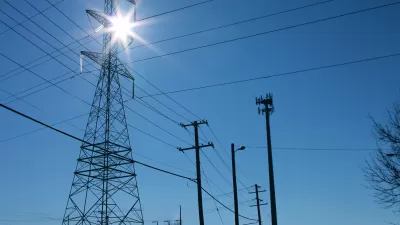Utilities profit from building more power plants—a flawed model for a diminishing natural monopoly.

David Roberts argues that New York State's Reforming the Energy Vision (REV) may be "the most important clean energy policy initiative in the country today." Not only can it change a poorly aligned incentive structure but also will contribute to national carbon reduction targets, setting an example for the rest of the country.
"Reforming utilities is a perilous process, with intense politics and high stakes. Reliable service must be maintained throughout any transition — it's like rebuilding an airplane in flight," Roberts warns. There remain many uncertainties about how and whether or not it will work, but he opines that New York's innovative vision is a clear path to real reform.
The REV will tackle grid inefficiencies by smoothing out the load profile - reducing congestion at peak energy hours. "To do that, it needs to encourage energy efficiency, demand shifting, and distributed energy resources (DER)s — all of which, in the traditional regulatory model, reduce utility revenue." This is because utilities make money by building more power plants—not by improving efficiency of existing plants.
To fill the gap in revenues from reduced capital expenditures, the REV proposes that utilities are restructured to be distributed service providers (DSPs), responsible for maintaining the grid but also involved in creating and managing “markets where third parties can compete to provide energy products and services on the retail side, things like energy storage, demand response, and distributed generation,” Roberts explains.
"The boundary of the [public utility's] natural monopoly has moved inward again. What remains of it is grid operations and reliability planning — that is, running the distribution grid itself. That's the only function that is still properly the purview of a publicly accountable, regulated utility."
FULL STORY: New York's revolutionary plan to remake its power utilities

Alabama: Trump Terminates Settlements for Black Communities Harmed By Raw Sewage
Trump deemed the landmark civil rights agreement “illegal DEI and environmental justice policy.”

Planetizen Federal Action Tracker
A weekly monitor of how Trump’s orders and actions are impacting planners and planning in America.

Why Should We Subsidize Public Transportation?
Many public transit agencies face financial stress due to rising costs, declining fare revenue, and declining subsidies. Transit advocates must provide a strong business case for increasing public transit funding.

Understanding Road Diets
An explainer from Momentum highlights the advantages of reducing vehicle lanes in favor of more bike, transit, and pedestrian infrastructure.

New California Law Regulates Warehouse Pollution
A new law tightens building and emissions regulations for large distribution warehouses to mitigate air pollution and traffic in surrounding communities.

Phoenix Announces Opening Date for Light Rail Extension
The South Central extension will connect South Phoenix to downtown and other major hubs starting on June 7.
Urban Design for Planners 1: Software Tools
This six-course series explores essential urban design concepts using open source software and equips planners with the tools they need to participate fully in the urban design process.
Planning for Universal Design
Learn the tools for implementing Universal Design in planning regulations.
Caltrans
Smith Gee Studio
Institute for Housing and Urban Development Studies (IHS)
City of Grandview
Harvard GSD Executive Education
Toledo-Lucas County Plan Commissions
Salt Lake City
NYU Wagner Graduate School of Public Service




























